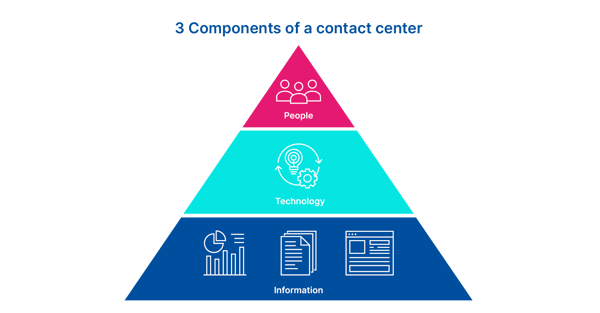Many customer service departments and agents feel underappreciated and it’s no surprise. Upper management often sees contact centers as a department that does nothing for the bottom line.
Customer service doesn’t directly generate revenue or launch new products and that leads to the dreaded “cost center” label. But contact centers offer three levels of value for companies from the operational to the strategic. Let’s look at each.
Value 1: Find Efficiency in Operations & Costs
According to ICMI, one of our favorite sources of thought leadership and events, contact center management is defined as:
“...the art of having the right number of properly skilled people and supporting resources in place at the right times to handle an accurately forecasted workload, at service level with quality.”
On a tactical and resource level, customer contact centers combine and deploy three important internal resources:
- People
- Information
- Technology
The ability to manage and improve each effectively while empowering them with the best technology plays a key role both in day to day performance, KPIs and of course costs.

Agent scheduling, workload forecasting, and real time optimization are crucial to both reducing costs and getting the biggest ROI out of your contact center. Make no mistake, poor organization or lack of optimization can and should lead to the "cost center" label.
Value 2: Increase Customer Satisfaction & Brand Loyalty
Contact centers' purpose is enabling companies to meet customer expectations. That means being there when needed with the information or service needed. It's not that different from emergency services.
Every customer inquiry is like a 911 call. Sure, some are more serious than others, but a customer is calling in a moment of need. That means an opportunity to deliver real value and cement the company-customer relationship. Dollars may not be directly involved but service is an extension of the value added by your product.

High levels of customer satisfaction, or CSAT in KPI terms, have been proven time and time again to correlate with positive business results such as market share, profits and word of mouth recommendations (i.e. higher NPS).
Your customers can easily share their experiences with both your products and services through online reviews and ratings, social media and the like.
That means customer experience has the ability to instantly impact both your reputation and ultimately business results nearly in real time. The happier customers are, the more they'll share their experiences with others and the more marketing dollars you’ll save.
Finally, customer support can also be an idea opportunity to up sell, cross sell or even retain customers ready to call it quits. This is especially true in industries like telecommunications or software. Your agents may be agents first, but are often salespeople second.
In the end, customers don’t remember price or even the details of your interactions. Customers remember how you made them feel. And that’s the deciding factor in whether they remain loyal and recommend you to others.
Value 3: Deliver Strategic Value for the Company
The amount of information generated from your contact centers is a powerful source of insight both on the operational and organizational levels. Imagine this scenario for example.
Your sportswear company has two contact centers located in different parts of the country. While looking at biweekly reports, you notice a spike in searches for “sole separating from shoe.” Intrigued, you drill down and find a slew of related and similarly-worded queries from various agents in both locations.
Pulling up your analytics dashboard for the last 6 months, you find nothing until two weeks ago when the searches began and continued to rise steadily. You also launched a new shoe model around exactly that time. You pull up the names of the most recent agents to perform that search and head down to the floor to investigate. After some quick discussion with agents, it appears there may be quality control issues at your factory overseas not to mention production. This enables your company to quickly address the production issues and nip the problem in the bud before it reaches general public awareness and costs skyrocket.
Contact centers are the tip of the spear. They’re your ears to the ground and often first indicators that something is amiss. One of the main reasons that contact centers are overlooked is because the wealth of data they generate - which can be turned into insight - is itself overlooked.
Therefore, having strong reporting and analytics capabilities and centralized customer service and knowledge management platform are key to both operational excellence and demonstrating strategic value within your organization.
Conclusion
Despite often not directly generating revenue, contact centers provide value to both your customers and company from the operational to strategic level. They impact both short term and long term KPIs from AHT to NPS and CSAT as well as indirectly influence things like market share, customer retention and revenue.
Customers don’t differentiate between your service and company as a whole. If they have a bad experience with one agent, they have a bad experience with the entire company. Finally, in order to best demonstrate the value internally, it is important to have strong analytics and reporting and regularly use those insights in organizational decision making.